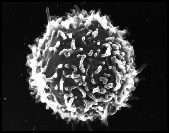|
|
|
|
|
|
|
|
|
|
|
|
|
|
|
|
|
|
|
|
Lymphocyte Traffic and Homing
|
|
|
|

|
|
|
|
|
|
|
|
|
are essential to in vivo immune responses
|
|
|
|
|
|
|
|
|
|
|
|
The immune system works like a single organ but its parts are located in many regions of the body. Integration of the parts occurs through a process, discovered by Sir James Gowans, called lymphocyte recirculation. So many cells leave the blood, cross tissues and return to the blood via efferent lymph that the total circulating pool of lymphocytes is turned over 10 to 48 times a day. Where do these cells go and what do they do? Lymphocytes are responsible for immunity. In order for them to work efficiently they have to (cont'd, left column)
|
|
|
|
|
|
|
|
|
|
|

|
|
|
|
|
|
|
|

|
|
|
|
|
|
|
|

Click on image above to see TEM
|
|
|
|
|
|
|
|
|

Click HERE to see High Endothelial Venule cross section
|
|
|
|
|
|
|
|
|
|
|
- Homing - go to where "professional" antigen presenting cells, dendritic cells, present antigens to the traveling cells. How do lymphocytes know where to go? We say "homing" takes them there, but this implies that they know where to go or have an ability to recognize direction. The story is far more complex and elegant than are these assumptions; and, homing must also account for incredible heterogeneity among T- and B-cells. The two major classes include types with functional specialization and commitment to secrete products that reflect extreme sub-specialization. These cells have specific routes to follow and places where they must go. How lymphocytes find where to leave the blood to initiate efficient immune reactions is an exciting research topic.
|
|
|
|
|
|
|
|
|
|
|
|
|
|
|
|
|
The invention of the scanning electron microscope enabled scientists to look at the surfaces of cells for the first time. What they found was that few cells have smooth round surfaces. Lymphocytes carried in blood or lymph have numerous finger-like structures (called microvilli) studding their surfaces. You can see them in all the pictures on this page. A beautiful idea suggested by SEM images was that homing receptors were on the tips of microvilli (Anderson & Anderson, 1976). The idea made sense. We experience objects by touching with our fingers. Lymphocytes experience where they are and interact through microvilli. Microvilli also seem sensitive to mechanical as well as chemical signals. Before emigrating, a lymphocyte sticks via microvilli to the luminal surface of an HEV endothelial cell (see SEM image above left). Firmly established microvillus contacts hold on like fingers in the holes of a bowling ball.
|
|
|
|
|
|
|
|
|
|
|
|
 |
|
|
|
|
|
|
|
|
|
|
|
|
|
|
|
|
|
|
|
|
|
|
|
|
|
|
|
|





